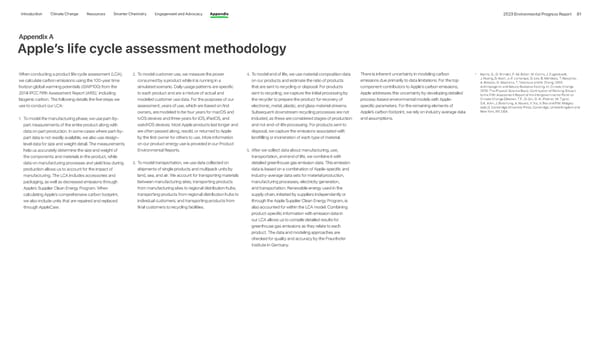Introduction Climate Change Resources Smarter Chemistry Engagement and Advocacy Appendix 2023 Environmental Progress Report 81 Appendix A Apple’s life cycle assessment methodology When conducting a product life cycle assessment (LCA), 2. To model customer use, we measure the power 4. To model end of life, we use material composition data There is inherent uncertainty in modeling carbon * Myhre, G., D. Shindell, F.-M. Bréon, W. Collins, J. Fuglestvedt, we calculate carbon emissions using the 100-year time consumed by a product while it is running in a on our products and estimate the ratio of products emissions due primarily to data limitations. For the top J. Huang, D. Koch, J.-F. Lamarque, D. Lee, B. Mendoza, T. Nakajima, A. Robock, G. Stephens, T. Takemura and H. Zhang, 2013: horizon global warming potentials (GWP100) from the simulated scenario. Daily usage patterns are specific that are sent to recycling or disposal. For products component contributors to Apple’s carbon emissions, Anthropogenic and Natural Radiative Forcing. In: Climate Change 2014 IPCC Fifth Assessment Report (AR5), * including to each product and are a mixture of actual and sent to recycling, we capture the initial processing by Apple addresses this uncertainty by developing detailed 2013: The Physical Science Basis. Contribution of Working Group I to the Fifth Assessment Report of the Intergovernmental Panel on biogenic carbon. The following details the five steps we modeled customer use data. For the purposes of our the recycler to prepare the product for recovery of process-based environmental models with Apple- Climate Change [Stocker, T.F., D. Qin, G.-K. Plattner, M. Tignor, use to conduct our LCA: assessment, years of use, which are based on first electronic, metal, plastic, and glass material streams. specific parameters. For the remaining elements of S.K. Allen, J. Boschung, A. Nauels, Y. Xia, V. Bex and P.M. Midgley (eds.)]. Cambridge University Press, Cambridge, United Kingdom and owners, are modeled to be four years for macOS and Subsequent downstream recycling processes are not Apple’s carbon footprint, we rely on industry average data New York, NY, USA. 1. To model the manufacturing phase, we use part-by- tvOS devices and three years for iOS, iPadOS, and included, as these are considered stages of production and assumptions. part measurements of the entire product along with watchOS devices. Most Apple products last longer and and not end-of-life processing. For products sent to data on part production. In some cases where part-by- are often passed along, resold, or returned to Apple disposal, we capture the emissions associated with part data is not readily available, we also use design- by the first owner for others to use. More information landfilling or incineration of each type of material. level data for size and weight detail. The measurements on our product energy use is provided in our Product help us accurately determine the size and weight of Environmental Reports. 5. After we collect data about manufacturing, use, the components and materials in the product, while transportation, and end of life, we combine it with data on manufacturing processes and yield loss during 3. To model transportation, we use data collected on detailed greenhouse gas emission data. This emission production allows us to account for the impact of shipments of single products and multipack units by data is based on a combination of Apple-specific and manufacturing. The LCA includes accessories and land, sea, and air. We account for transporting materials industry-average data sets for material production, packaging, as well as decreased emissions through between manufacturing sites; transporting products manufacturing processes, electricity generation, Apple’s Supplier Clean Energy Program. When from manufacturing sites to regional distribution hubs; and transportation. Renewable energy used in the calculating Apple’s comprehensive carbon footprint, transporting products from regional distribution hubs to supply chain, initiated by suppliers independently or we also include units that are repaired and replaced individual customers; and transporting products from through the Apple Supplier Clean Energy Program, is through AppleCare. final customers to recycling facilities. also accounted for within the LCA model. Combining product-specific information with emission data in our LCA allows us to compile detailed results for greenhouse gas emissions as they relate to each product. The data and modeling approaches are checked for quality and accuracy by the Fraunhofer Institute in Germany.
 Apple Environmental | Immersive Page 80 Page 82
Apple Environmental | Immersive Page 80 Page 82